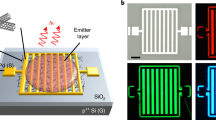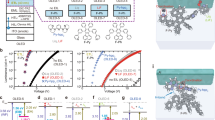Abstract
Emission of light from excited-state dye molecules can be driven by the electron transfer between electrochemically generated anion and cation radicals — a process known as electrochemiluminescence1,2,3,4,5 (ECL). ECL has been investigated for both display6 and laser applications7,8,9. The latter is of particular interest as, in contrast to conventional dye lasers, a laser operating by this principle would not require an additional laser source optically to pump the dye into the required excited state, and may offer additional advantages in terms of power, tunability and range of available wavelengths. But the pumping rate hitherto achieved by ECL is two orders of magnitude lower than the optical pumping threshold9. Here we describe a device structure designed to enhance the efficiency of the ECL process, and present evidence that laser action has been realized in such a structure: the ECL spectrum is strongly modulated by the device structure, the output intensity shows a clear threshold as the drive current increases, and spectral narrowing is observed as the intensity increases.
This is a preview of subscription content, access via your institution
Access options
Subscribe to this journal
Receive 51 print issues and online access
$199.00 per year
only $3.90 per issue
Buy this article
- Purchase on Springer Link
- Instant access to full article PDF
Prices may be subject to local taxes which are calculated during checkout





Similar content being viewed by others
References
Feldberg, S. W. Theory of controlled potential electrogeneration of chemiluminescence. J. Am. Chem. Soc. 88, 390–393 (1966).
Maloy, J. T., Prater, K. B. & Bard, A. J. Electrogenerated chemiluminescence. II. The rotating ring-disk electrode and the pyrene-N,N,N′,N′-tetramethyl-p -phenylenediamine system. J. Phys. Chem. 72, 4348–4350 (1968).
Keszthelyi, C. P., Tokel-Takvoryan, N. E. & Bard, A. J. Electrogenerated chemiluminescence: Determination of the absolute luminescence efficiency in electrogenerated chemiluminescence. 9,10-Diphenylanthracene-thianthrene and other systems. Anal. Chem. 47, 249–256 (1975).
Bartelt, J. E., Drew, S. M. & Wightman, R. M. Electrochemiluminescence at band array electrodes. J. Electrochem. Soc. 139, 70–74 (1992).
Collinson, M. M., Pastore, P., Maness, K. M. & Wightman, R. M. Electrochemiluminescence interferometry at microelectrodes. J. Am. Chem. Soc. 116, 4095–4096 (1994).
Schaper, H., Koestlin, H. & Schnedler, E. New aspects of d.c. electrochemiluminescence. J. Electrochem. Soc. 129, 1289–1294 (1982).
Measures, R. M. Prospects for developing a laser based on electrochemiluminescence. Appl. Opt. 13, 1121–1133 (1974).
Measures, R. M. Physical constraints associated with the development of a laser based on electrochemiluminescence. Appl. Opt. 14, 909–916 (1975).
Heller, C. A. & Jernigan, J. L. Electrochemical pumping of laser dyes. Appl. Opt. 16, 61–66 (1977).
Myer, J. A., Johnson, C. L., Kierstead, E., Sharma, R. D. & Itzkan, I. Dye laser stimulation with a pulsed N2laser line at 3371 å. Appl. Phys. Lett. 16, 3–5 (1970).
Ujihara, K. Asimple relationship between directivity and linewidth of a planar microcavity laser. Jpn J. Appl. Phys. 33, 1059–1060 (1994).
Hakki, B. W. & Paoli, T. L. CW degradation at 300°K of GaAs double-heterostructure junction lasers. II. Electronic gain. J. Appl. Phys. 44, 4113–4119 (1973).
Hakki, B. W. & Paoli, T. L. Gain spectra in GaAs double-heterostructure injection lasers. J. Appl. Phys. 46, 1299–1306 (1975).
Acknowledgements
We are grateful to M. Morita for encouragement and support.
Author information
Authors and Affiliations
Corresponding author
Rights and permissions
About this article
Cite this article
Horiuchi, T., Niwa, O. & Hatakenaka, N. Evidence for laser action driven by electrochemiluminescence. Nature 394, 659–661 (1998). https://doi.org/10.1038/29260
Received:
Accepted:
Issue Date:
DOI: https://doi.org/10.1038/29260
This article is cited by
-
Electrochemiluminescence Imaging Techniques for Analysis and Visualizing
Journal of Analysis and Testing (2020)
-
The potential of optofluidic biolasers
Nature Methods (2014)
-
Emission enhancing characteristics in electrochemiluminescence devices by 9,10-diphenylanthracene dye-highly scattering TiO2 solid-nanoparticle mixture
Applied Physics B (2010)
Comments
By submitting a comment you agree to abide by our Terms and Community Guidelines. If you find something abusive or that does not comply with our terms or guidelines please flag it as inappropriate.



